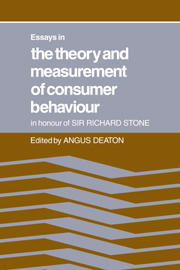Book contents
- Frontmatter
- Contents
- Foreword
- List of contributors
- Part one The analysis of commodity demands
- Part two The theory of index numbers
- Part three The consumption function and durable goods
- Part four Other aspects: fertility and labour supply
- Introduction
- 10 On labour supply and commodity demands
- 11 Child spacing and numbers: an empirical analysis
- Bibliography of Sir Richard Stone's works 1936–79
- Index of names
- Subject index
10 - On labour supply and commodity demands
Published online by Cambridge University Press: 05 November 2011
- Frontmatter
- Contents
- Foreword
- List of contributors
- Part one The analysis of commodity demands
- Part two The theory of index numbers
- Part three The consumption function and durable goods
- Part four Other aspects: fertility and labour supply
- Introduction
- 10 On labour supply and commodity demands
- 11 Child spacing and numbers: an empirical analysis
- Bibliography of Sir Richard Stone's works 1936–79
- Index of names
- Subject index
Summary
Introduction
The study of labour supply and commodity demands has, for the most part, proceeded on separate lines. There has been an extensive literature, much of it inspired by the work of Sir Richard Stone (see, for example, Stone 1954), on the estimation of commodity demand systems; and there has been a recent growth of interest in labour supply equations. However, there have been relatively few attempts to estimate jointly labour supply and commodity demand relationships. At a theoretical level, the main contribution to linking these two aspects of household decision-making has been in the work on household production. The ‘activities’ approach, developed particularly in Becker's theory of the allocation of time (1965), provides considerable insight, but has not been widely adopted in empirical research. In this paper we build on Becker's theoretical work and develop the activities approach as the basis for an econometric investigation of the joint determination of labour supply and commodity demand in the United Kingdom.
We begin in section 2 by discussing the household allocation of income and time, and relating it to the theory of rationing. To illustrate the extension of the standard consumer demand model, we take in section 3 the case of the linear expenditure system. This provides the basis for the empirical work, which uses data on expenditure by commodity category, and hours of work, contained in the Family Expenditure Survey for the United Kingdom.
- Type
- Chapter
- Information
- Essays in the Theory and Measurement of Consumer Behaviour: In Honour of Sir Richard Stone , pp. 265 - 296Publisher: Cambridge University PressPrint publication year: 1981
- 9
- Cited by



